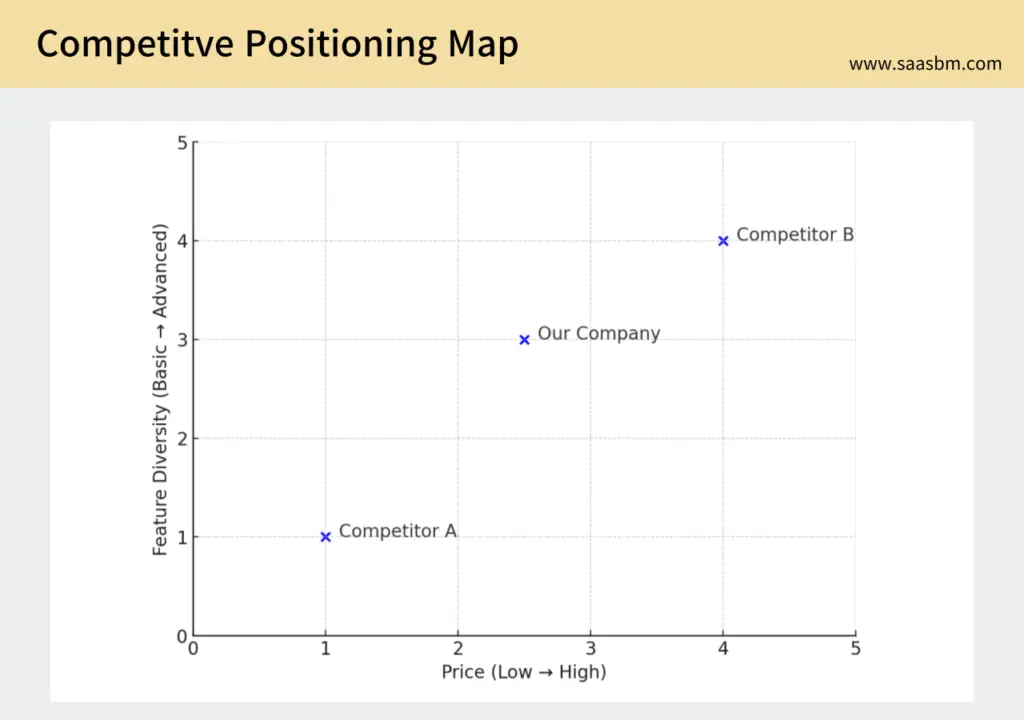Introduction
If you’re building a SaaS product, you might be wondering:
“How do I clearly show how we’re different from the competition?”
Most startups think it’s enough to list product features or pricing tiers.
But customers — and investors — need more than a bullet list.
They want to see:
👉 Where do you stand in the market?
👉 What makes you different?
👉 Why should they choose you over others?
This is where the Competitive Positioning Map comes in.
In this guide, you’ll learn:
- What the Competitive Positioning Map is
- Why it matters for SaaS businesses
- A real-world SaaS example
- How to apply it to your own startup
- Common mistakes to avoid
Let’s dive in.
What is the Competitive Positioning Map?
The Competitive Positioning Map is a visual strategy tool that helps you define your product’s position relative to competitors.
It’s built on two axes — usually the most important factors in your market — and shows where each product falls.
Think of it as a 2D battlefield for your SaaS product.
For example:
- X-axis: Price (Low to High)
- Y-axis: Feature Complexity (Basic to Advanced)
By plotting products on this grid, you instantly reveal:
✅ Who’s dominating which area
✅ Where your product fits
✅ Which segments are under-served
This tool turns vague statements like “we’re simpler than others” into clear visual strategy.

Why It Matters for SaaS Startups
SaaS markets are often crowded. If you don’t stand out, you get lost.
Here’s why Competitive Positioning is mission-critical:
✅ Clarify Differentiation
Clearly show how your product compares on dimensions that matter to customers.
✅ Identify Opportunities
Find gaps in the market that your competitors have ignored.
✅ Shape Product Roadmaps
Guide your team on whether to improve pricing, features, UI, or integrations.
✅ Align Marketing & Sales
Craft messages that directly explain how you’re different — and why it matters.
✅ Communicate With Investors
Investors love maps. It shows you understand the market and your place in it.
Example: SaaS Collaboration Tool – TeamFlow
Let’s say you’re building TeamFlow, a new team collaboration SaaS.
You map the landscape:
- X-axis: Price (Low → High)
- Y-axis: Specialization (General-purpose → Role-specific)
Now you plot:
- Slack: Mid-price, general-purpose
- Microsoft Teams: High-price, enterprise-focused
- Discord: Free, general-purpose for informal use
- TeamFlow (Your SaaS): Affordable, designed for design teams
You realize no one is targeting affordable tools specifically designed for creative professionals.
That’s your sweet spot.
How to Build Your Own Competitive Map
- Choose the Right Axes
Don’t pick random traits. Ask:- What matters most to my target customer?What are the top decision-making factors?
- Price vs Feature Complexity
- Ease of Use vs Customization
- Enterprise Fit vs Startup Fit
- List Your Competitors
Include not only direct competitors, but substitutes (e.g., Excel, Notion, Trello). - Plot Each Product Honestly
Don’t exaggerate. This is for your team’s clarity, not just investor slides. - Analyze the Gaps
Where are the underserved zones?
Where is everyone clustering? - Craft a Positioning Statement
Example: “TeamFlow offers mid-priced, design-centric collaboration for creative teams — a segment underserved by Slack and Teams.”
Common Mistakes to Avoid
❌ Using vague axes like “innovation” or “coolness”
✅ Use measurable, customer-relevant dimensions
❌ Only plotting yourself and one competitor
✅ Include 4–6 players to see the full picture
❌ Making the map and never updating it
✅ Revisit every 6–12 months as the market evolves
Summary
| Common Approach | Positioning Map Approach |
|---|---|
| Focus on features | Focus on strategic differentiation |
| Talk about pricing tiers | Show where you stand in the market |
| Guess who your competitors are | Analyze actual alternatives and substitutes |
| Build roadmap blindly | Use map to guide product direction |
Final Thoughts
The Competitive Positioning Map is more than a slide — it’s a strategy tool.
It helps you visually define:
- What your product stands for
- What segment you serve best
- Where you have a chance to win
Before your next investor pitch, product meeting, or go-to-market plan, ask yourself:
👉 “Can I clearly show how we’re different?”
If the answer is “Not yet,”
build your Competitive Positioning Map — and find your space to win.

No comment yet, add your voice below!